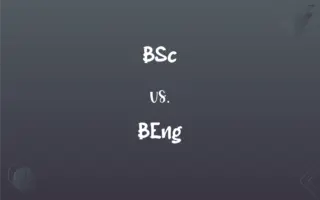Scythe vs. Sickle: What's the Difference?
Edited by Aimie Carlson || By Harlon Moss || Published on February 22, 2024
A scythe is a long-handled, large-bladed tool for cutting grass or grain; a sickle is a short-handled, curved-blade tool for hand-held cutting.

Key Differences
Design: A scythe typically features a long, straight handle (snath) with a long, curved blade at one end, designed for mowing grass or reaping crops with a sweeping motion. A sickle, on the other hand, has a short handle and a short, crescent-shaped blade, suitable for hand-held cutting of grain or grass.
Scythes are used in a standing position, swinging the tool in a wide arc to cut larger swathes of vegetation, making them efficient for open fields. Sickles, being smaller and hand-held, are used for more precise cutting, such as harvesting specific plants or working in tight spaces.
The scythe, with its longer handle, is a more recent agricultural innovation compared to the sickle. The sickle's design dates back to ancient times and was a primary tool for small-scale harvesting, while the scythe allowed for more efficient large-scale farming.
Both tools have rich symbolic meanings. The scythe, often associated with the Grim Reaper, symbolizes death and the passage of time. The sickle, historically used in peasant agriculture, has become a symbol of agrarian labor and revolution, as seen in the Soviet hammer and sickle emblem.
Modern machinery has largely replaced these tools in large-scale agriculture, both the scythe and the sickle remain in use for small-scale farming, gardening, and cultural practices. The scythe is often preferred for its efficiency in cutting large areas, whereas the sickle is chosen for delicate, selective cutting tasks.
ADVERTISEMENT
Comparison Chart
Handle Length
Long
Short
Blade Shape
Long and curved
Short and crescent-shaped
Usage Position
Standing
Hand-held
Cutting Motion
Sweeping, wide arcs
Precise, localized cuts
Ideal for
Mowing grass, reaping crops in open fields
Harvesting specific plants, tight spaces
ADVERTISEMENT
Symbolism
Death, passage of time (Grim Reaper)
Agrarian labor, revolution (hammer and sickle)
Scythe and Sickle Definitions
Scythe
A tool with a long handle and a broad curved blade for cutting grass.
He swung the scythe expertly, cutting a wide swath of hay.
Sickle
A tool dating back to ancient civilizations for crop harvesting.
Ancient Egyptians were depicted using sickles in hieroglyphics.
Scythe
A tool reflecting the evolution of agricultural efficiency.
The introduction of the scythe revolutionized grain harvesting.
Sickle
In symbolism, a representation of agricultural labor or political movements.
The sickle is part of the emblem representing workers' solidarity.
Scythe
A traditional farming implement used before modern mechanization.
The museum displayed an antique scythe used in the 19th century.
Sickle
An object with historical and cultural significance in agriculture.
The sickle is often seen in traditional celebrations related to harvest.
Scythe
A hand tool for mowing fields and cutting tall vegetation.
John used a scythe to mow the wild meadow on his property.*
Sickle
A hand-held agricultural tool with a curved blade for cutting crops.
She used a sickle to carefully harvest the ripe wheat.
Scythe
In symbolism, a representation of death or the Grim Reaper.
The character dressed as Death carried a scythe.
Sickle
A tool for precise cutting in farming, especially in tight spaces.
The gardener used a sickle to trim the edges of the field.
Scythe
An implement consisting of a long, curved single-edged blade with a long handle, used for mowing or reaping.
Sickle
An implement having a crescent-shaped blade attached to a short handle, used for cutting grain or tall grass.
Scythe
To cut with or as if with a scythe.
Sickle
The cutting mechanism of a reaper or mower.
FAQs
How is a sickle different from a scythe?
A sickle has a shorter handle and blade, used for hand-held cutting.
What is the symbolic meaning of a scythe?
It often symbolizes death or the Grim Reaper.
Can a scythe be used for small gardens?
It's less practical; scythes are better suited for larger areas.
Why is the sickle part of the Soviet emblem?
It represents agricultural labor and peasantry.
Are scythes efficient for farming today?
They are efficient for certain tasks but largely replaced by machinery.
Can children use a sickle safely?
With supervision and proper instruction, it's possible.
Are sickles used in any sports?
No, they're not suitable for sports.
What is a scythe used for?
To cut grass or grain, especially in large, open areas.
Is the sickle still used today?
Yes, particularly in small-scale agriculture and gardening.
How do you sharpen a scythe?
Using a whetstone or grinder, following the blade's curve.
Was the scythe used in warfare?
Rarely; it's primarily an agricultural tool.
Is there a modern version of the scythe?
Modern versions exist, often with ergonomic designs.
How long does a scythe blade last?
With proper maintenance, several years.
Is the sickle used in any religious rituals?
In some cultures, it's used in harvest festivals.
Why is the sickle curved?
The curve helps in efficient cutting and harvesting.
What is the best way to use a sickle?
With precise, controlled hand movements for cutting.
Can a scythe cut through thick brush?
Yes, especially with a well-sharpened blade.
What materials are scythes made from?
Typically wood for the handle and steel for the blade.
Can a scythe be decorative?
Yes, especially antique or artistically crafted ones.
How did the sickle evolve over time?
It became more ergonomic but retained its basic shape.
About Author
Written by
Harlon MossHarlon is a seasoned quality moderator and accomplished content writer for Difference Wiki. An alumnus of the prestigious University of California, he earned his degree in Computer Science. Leveraging his academic background, Harlon brings a meticulous and informed perspective to his work, ensuring content accuracy and excellence.
Edited by
Aimie CarlsonAimie Carlson, holding a master's degree in English literature, is a fervent English language enthusiast. She lends her writing talents to Difference Wiki, a prominent website that specializes in comparisons, offering readers insightful analyses that both captivate and inform.






































































